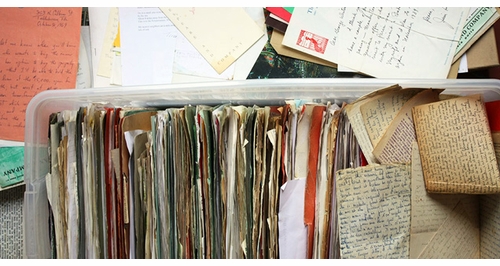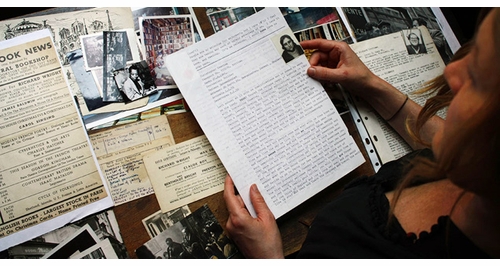| RECENT POSTS DATE 12/11/2025 DATE 12/8/2025 DATE 12/3/2025 DATE 11/30/2025 DATE 11/27/2025 DATE 11/24/2025 DATE 11/22/2025 DATE 11/20/2025 DATE 11/18/2025 DATE 11/17/2025 DATE 11/15/2025 DATE 11/15/2025 DATE 11/14/2025
| | | KRISTA HALVERSON | DATE 9/1/2016The editor of the magnificent new 384-page illustrated history of the legendary Paris literary bookstore (and home-away-from-home to decades of expatriate writers and cultural figures) contributes a text on the making of a book which had to be gotten right, whose archive never stops growing, and whose motto, inscribed above the library door in the rue de la Bûcherie store founder George Whitman's own hand, reads, "Be not inhospitable to strangers lest they be angels in disguise."
BIOGRAPHY OF A BOOKSTORE
Krista Halverson
For two years, from 2012 to 2014, I could be found tucked into George Whitman's former bedroom, his cat, Kitty, on my lap, reading and sorting Shakespeare and Company’s archives. It was the first and the most daunting task in creating a history book about the shop. George’s apartment, two floors above the bookstore, housed a century’s worth of correspondence, photographs, documents, author memorabilia and ephemera, both mundane and precious—all of it mostly unsorted, stashed into various old wine crates and big plastic tubs, stuffed under the bed and bureau and sink, and even piled atop the water tank in the bathroom. That’s where George’s daughter, Sylvia, unearthed one of Gregory Corso’s notebooks, with handwritten drafts of poems and sketches, from 1961.
I’d first arrived in Paris in late 2011, after having left my position at an art and fiction magazine, Zoetrope: All-Story, in San Francisco. My friend Elaine Katzenberger at City Lights introduced me to Sylvia, who’d been managing Shakespeare and Company since 2005, when her father handed her the reins. It happened that Sylvia was looking to create a book about the shop’s history. She asked, would I be able to help out while I was in France? Of course, gladly and gratefully. At first, we thought we could keep the project simple and straightforward. I extended my stay in Paris by six weeks. And then I extended it another six weeks, and then another, to what eventually turned into four years as the scale and scope of the project grew.
In addition to Corso’s notebook, we came upon more than ten thousand Tumbleweed autobiographies, along with thousands more thank-you notes and updates from former guests, announcements of books published and children born, requests to stay at the bookshop. There were poems, novels, memoirs, artwork, pressed flowers and woven bracelets—all gifts to George. There were resumes dating back to 1973, one adhered to a letter from Anaïs Nin by a dead cockroach. There were more dead cockroaches and more letters from Nin, as well as a copy of her will, reportedly left with George for “safekeeping.” There was correspondence from Allen Ginsberg, Lawrence Ferlinghetti, Carolyn Cassady, Paul Bowles, Graham Greene, Lawrence Durrell, Noam Chomsky, and Upton Sinclair. There were documents about shipping English-language books from the U.S. and U.K., taxes, banks, cellars, burst water pipes, all manner of French business bureaucracy. There were audiocassettes and floppy discs and VHS tapes and CDs and DVDs. There were thousands of press clippings and random business cards, along with one from a now-famous and seemingly unlikely visitor, Dick Cheney, then CEO of Halliburton. There were a near-endless number of photographs; plus, George’s diaries, travel journals and correspondence, including 20 years of missives from his mother, who never stopped insisting her son would soon weary of Paris and return to the States.
Every time I thought I’d come to the end of the shop’s archives, I’d celebrate with a glass of champagne at a nearby café. Invariably, a few weeks or maybe even a couple months later, David Delannet—the bookstore’s co-manager and Sylvia’s fiancé—would arrive from home or the shop’s storage unit with yet another bin of papers.
Shakespeare and Company has always been a place where oral storytelling thrives, where tales are passed from one generation of staff to the next, from one week’s Tumbleweeds to the following week’s. As I sorted and read and filed the archives, current and former employees, guests and George’s “comrades” (as he called those he liked) stopped by to share their favorite shop stories. I heard tales of Henry Miller and Lawrence Durrell’s midnight rendezvous at the bookstore, Maria Callas arriving in dark sunglasses hoping not to be recognized and Italo Calvino and Pablo Neruda drinking wine from old tuna tins, as well as George’s hinting to Tumbleweeds of an affair with Anaïs Nin, and his gathering together customers to help welcome back “an old friend, the ‘Millionaire Communist’ Allen Ginsberg.”
With all this material before me, I began envisioning how the history project would take shape. I wanted to create a book like a box of treasures that would be valuable both to those who know the shop well and to those who’ve only just learned of it. A book that would, as much as possible, recreate my experience sitting in George’s bedroom, discovering amazing photographs—like the one of Langston Hughes reciting poetry to jazz accompaniment or George in his pajamas posing next to former President Bill Clinton—and precious ephemera, such as a 1956 promotional flyer advertising events with both James Baldwin and Richard Wright. I wanted readers to encounter some of the same newspaper articles I had, to get a perspective of the bookstore within the span of Paris history, including the arrival of the Beats in the 1950s, the May ’68 student protests and the feminist movement of the 1970s. I wanted to share visitors’ memories, too, and in their own voices—stories I’d discovered in letters from the archive, audiocassettes and VHS tapes, interviews and conversations, and from our open call for submissions announced on social media. Finally, of course, I wanted to present all of these elements alongside the kind of dates and facts that make up any history book.
The result, Shakespeare and Company, Paris: A History of the Rag & Bone Shop of the Heart, debuts around the world in late September. The book is almost 400 pages and features more than 300 images and 70 editorial contributions, including personal essays, diary entries and poems from Lawrence Ferlinghetti, Allen Ginsberg, Anaïs Nin, Nathan Englander, Dervla Murphy, David Rakoff, Ian Rankin, Kate Tempest and Ethan Hawke, among other shop visitors.
A few weeks ago, David conjured up yet another large tub of bookstore papers (and with the promise to treat me to my next glass of champagne). Whatever’s in the bin will have to wait for the book’s second edition, but that seems fitting in a way. The history of Shakespeare and Company is a story always being written, with new sentences added each day. George once said: “I created this bookstore like a man would write a novel, building each room like a chapter, and I like people to open the door the way they open a book, a book that leads into a magic world in their imaginations.”
KRISTA HALVERSON is the director of Shakespeare and Company bookstore’s publishing venture. Previously, she was the managing editor of Zoetrope: All-Story, the art and literary quarterly published by Francis Ford Coppola, which has won several National Magazine Awards for Fiction and numerous design prizes. She was responsible for the magazine’s art direction, working with guest designers including Lou Reed, Kara Walker, Mikhail Baryshnikov, Zaha Hadid, Wim Wenders and Tom Waits, among others.
 Shakespeare and Company Paris
Hbk, 6.25 x 9.5 in. / 384 pgs / 225 color.
| |
|



